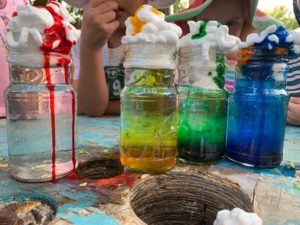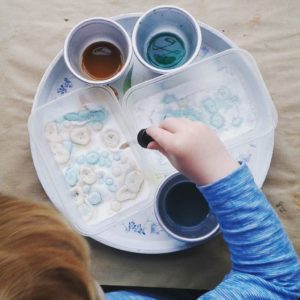Science Fun @Home
Try some of these fun science based activities at home with items you can find around the house.
Shaving Cream Rain Clouds

By: Alpha - CC BY-NC 2.0
Materials
- 1 clear vase or glass jar
- Water
- Shaving cream
- Liquid food colouring
Directions
- Fill the clear jar about three-quarters full with water.
- Fill the rest of the jar with shaving cream.
- Add a few drops of different coloured food colouring on top of the shaving cream.
You will see the colours start to weave their way through the shaving cream cloud and into the water.
The Science
This is a fun simple experiment that looks at weather concepts and colour mixing.
As the water (food colouring) gets too heavy for the cloud (shaving cream) it begins to release water into the atmosphere, creating ‘rain’. This experiment never gets old as there are so many colour combinations to try.
Variations
Try making a small cloud and a large cloud.
How much longer does it take the colouring to make its way through the large cloud versus the small cloud?
Try making clouds of different colour combinations.
Can you make green rain?
Troubleshooting
If you find it is taking a while for the colour to make its way through the cloud, it is probably because you made a very large cloud. You can speed up the process by adding a little plain water to the cloud. Very soon you should have beautiful streaks of colour making their way into the water.
Walking Water

Materials
- Water
- 6 clear glass or plastic cups
- Red yellow and blue food colouring
- 6 paper towels
Directions
- Pour water into 3 of the glasses until they are about three-quarters full.
- Add a few drops of food colouring to each of the filled glasses so you have one red cup, one blue cup and one yellow cup of liquid.
- Arrange the cups in a circle alternating 1 cup of water and 1 empty cup.
- Fold each paper towel in half and then in half again vertically to make long strips.
- Place one end of a strip in an empty glass and the other end in a glass filled with water.
- Take the next strip and place it in the same glass of water then place the other end in an empty glass.
- Repeat until all of the glasses are linked to each other by paper towel strips. The paper towels will immediately start to soak up the water.
- Wait several hours or even overnight and see what happens.
The Science
The water will slowly move from the full glasses to the empty ones, mix and create new colours.
This happens via a process called capillary action.
The water travels up the tiny gaps in the fibres of the paper towel. This is similar to how water travels up trees from the roots to the leaves.
Variations
Try different colour combinations using the food colouring.
Can you make teal, brown or lime green?
Bi-carb and vinegar

By: cathredfern - CC BY-NC 2.0
Materials
- Bicarbonate of soda (bi-carb)
- Vinegar
- Plastic cups or bowls
- Bubble bath or dish washing liquid (optional)
- Food colouring (optional)
Directions
- Place a small amount (about a tablespoon) of bi-carb in a plastic cup
- Pour in some vinegar
- Watch the fantastic reaction
The Science
Bicarbonate of soda is a base and vinegar is a weak acid.
When you mix them this produces a reaction that creates carbon dioxide, which makes the bubbles that appear.
Variations
There is so much you can do with bi-carb and vinegar.
- Try adding some bubble bath or food colouring to your experiments and setting up multiple experiments.
- Try bi-carb with the bubble bath sitting on top then bi-carb with the bubble bath mixed in.
- Is the reaction different when you pour in the vinegar?
- How about if you add the bubble bath to the vinegar instead?
- You can also do some colour mixing as well by adding a drop of food colouring to your experiments.
Want to try some more experiments?
Check out these great ebooks from Logan City Council's Collection

